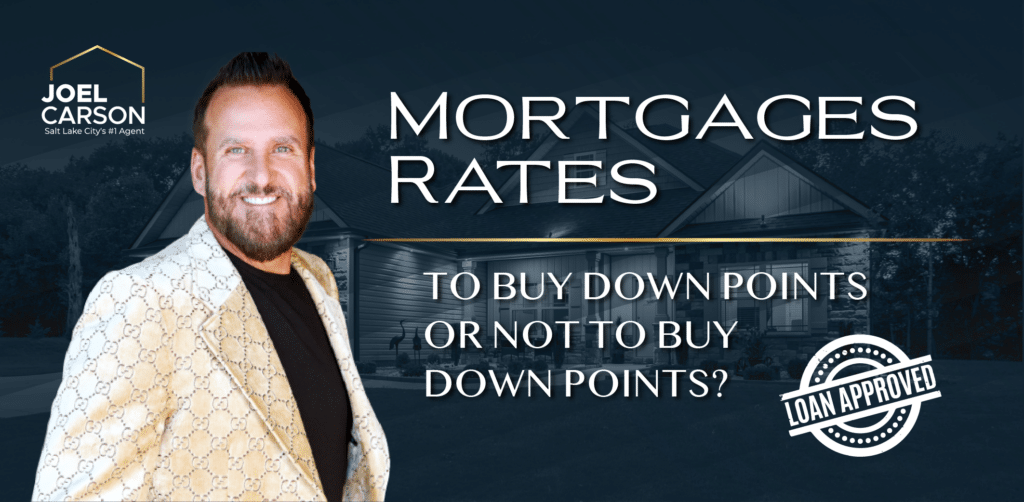
High mortgage rates increase buydowns
Mortgage rates are dynamic. They constantly change with a set of circumstances that fluctuate regularly. Many factors are beyond your control, but you can directly influence others. An interest rate buy down is one loan product that allows you to reduce your mortgage rate permanently or temporarily. The good news is, this can reduce your monthly mortgage payments. The bad news is, you will have to pay extra when your loan closes.
Sam Ivey, an Academy Mortgage loan officer said buying down points is a popular option today. High interest rates and low inventory have cooled off what was a very hot housing market in recent years. In some cases, the low inventory is causing bidding wars. “In other cases, homes will sit there and not sell for months. That’s a good time to get those points paid for by the seller. When a home is not moving, the seller is really pretty eager to buy those down to get their home sold,” Ivey said.

When a home is not moving, the seller is really pretty eager to buy those [points] down to get the home sold.
~Sam Ivey
Academy Mortgage Loan Officer
Some companies are building a point buydown right into the rate. The variables are so vast that it’s difficult to determine just what it will cost you to buy your rate down. If the points are built into the rate, you might have the option of receiving credit back on your loan if you choose to go with a higher mortgage interest rate.
Many factors go into determining the cost of a buydown but the following is a rough example of the cost:
- A couple buys a home for $400,000
- They have a 750 credit score
- They make a 5 percent down payment on ($20,000)
- The interest rate is 7.5 percent (just over par)
- The buyers want to buy the rate down to 7.375 percent (slightly under par)
- The cost to the buyer would be about $475.00
Because interest rates are higher today than in the recent past, Ivey said roughly 80 percent of his clients buy down the interest rate.
Let’s dig into interest rate buydowns
First, we’ll briefly discuss the history of mortgages and mortgage rates. Then we’ll discuss the many factors that influence interest rates. Finally, we’ll discuss interest rate buydowns and try to answer the following questions:
- What is an interest rate buy-down?
- What are mortgage points?
- How does an interest rate buydown work?
- What are the pros and cons of using an interest-rate buydown?
- Are there limits to this method?
What are mortgage points?
In the context of mortgages, “points” refer to upfront fees that borrowers can pay to the lender at the time of closing to reduce the interest rate on the loan. Each point typically costs 1 percent of the total loan amount. The decision to pay points is essentially a trade-off between paying more upfront in exchange for a lower interest rate over the life of the loan.
There are two types of points commonly used in mortgage transactions:
- Discount Points:
- Discount points are fees paid directly to the lender at closing in exchange for a lower interest rate. Each discount point typically reduces the interest rate by a specific percentage, often 0.25 percent. For example, paying one discount point might lower the interest rate from 4.5% to 4.25%.
- Origination Points:
- Origination points are fees charged by the lender for processing the loan application. Unlike discount points, origination points do not directly reduce the interest rate. Instead, they are a form of compensation for the lender’s services. It’s essential for borrowers to distinguish between discount points and origination points and to understand how each affects the overall cost of the mortgage.
The decision to pay points depends on the borrower’s financial situation, how long they plan to stay in the home, and their preference for upfront costs versus long-term interest savings. Paying points can make sense for borrowers who intend to stay in the home for an extended period, as the lower interest rate will result in savings over time. However, for those planning to move or refinance soon, the upfront cost of points may outweigh the long-term benefits.
How did home mortgages begin?
No, cavemen did not have mortgages. You might be surprised to learn that the modern-day mortgage was born in 1934 along with the Federal Housing Administration (FHA). A Bankrate.com article by Andrew Dehan was published on Dec. 20, 2023. “Mortgage rate history: 1970s to 2023” reviews the sordid past of interest rates that have had some riding the market like a Lagoon roller coaster for years.
Dehan said only one in 10 Americans owned a home before 1934. “It was a luxury available only for cash or with a very short-term loan,” he said. “That all changed with the development of the 30-year fixed-rate mortgage during the Great Depression, and the perfection of it after World War II.” The installment plan changed the housing industry significantly. Suddenly, millions of Americans could see a path to home ownership – and they took that path in droves.
When mortgages became popular, Americans began monitoring mortgage interest rates.
What is the FOMC?
The Federal Open Markets Committee (FOMC) is the monetary policymaking part of the Federal Reserve that meets eight times a year to set the federal funds rate. The Fed does not set interest rates, but the federal funds rate is very closely tied to mortgage rates.
January 2024 started with some pretty perky interest rates. A person with a 700 to 719 credit score could get a $300,000 home with 20 percent down on a conventional loan for a rate of about 7.578 percent. An FHA rate would be about 6.847 percent, and a VA rate would come in at about 6.724 percent.
That might seem astronomical to those of us who were spoiled with rates near 2 to 3 percent in 2021 (the federal funds rate hovered at zero temporarily). The Federal Reserve Chairman lowered rates to compensate for the havoc COVID-19 wreaked on the American economy. The boost worked and suddenly the economy got hot, hot, hot. To help slow it down, the Fed got aggressive. Over 16 months, the central bank raised the federal funds rate by more than five percentage points.
While today’s rates seem high, we expect them to go down in 2024. Also, (just to make you feel better) at the end of 1979, the 30-year fixed mortgage rate was 12.9 percent. Chin up.
Many factors influence mortgage rates
Mortgage rates are determined by a combination of factors, and the process involves a complex interplay between economic indicators, financial markets, and individual borrower characteristics.
Here are the key factors that influence how mortgage rates are determined:
- Economic Indicators:
- Inflation: The United States inflation rate is central to the formula. Lenders try to set interest rates that provide a return higher than the anticipated inflation rate.
- Economic Growth: Lenders consider the state of the economy, including factors like gross domestic product (GDP) growth, employment rates, and consumer spending, as indicators of the overall economic health.
- Federal Reserve Policies:
- The Federal Reserve, the central bank of the United States, plays a significant role. The Fed sets the federal funds rate, which influences short-term interest rates. Changes in the federal funds rate can impact mortgage rates.
- Global Economic Conditions:
- Global economic conditions and geopolitical events can influence financial markets, affecting the demand for U.S. Treasury bonds. Mortgage rates often track the yields on these bonds.
- Bond Market Movements:
- Mortgage-backed securities (MBS), which are bundles of mortgages sold to investors, are a key factor. When demand for MBS increases, mortgage rates tend to decrease, and vice versa.
- Credit Risk and Loan Characteristics:
- Borrower-specific factors, such as credit score, down payment amount, loan amount, and loan term, can impact the interest rate offered to an individual borrower. Higher credit scores and larger down payments may lead to lower interest rates.
- Loan Type and Term:
- Different loan types (e.g., fixed-rate vs. adjustable-rate mortgages) and loan terms (e.g., 15-year vs. 30-year) come with different risk profiles for lenders, influencing the interest rates associated with each.
- Lender Costs and Profit Margins:
- Lenders factor in their operational costs and desired profit margins when they set interest rates. This includes expenses related to loan origination, servicing, and administrative overhead.
- Market Competition:
- The level of competition among lenders in the mortgage market can influence the rates they offer. Increased competition may lead to lower rates to attract borrowers.
- Housing Market Conditions:
- The state of the housing market, including home prices and inventory levels, can impact mortgage rates. Strong demand for homes may put upward pressure on rates.
- Government Policies and Programs:
- Government initiatives, such as policies to encourage homeownership or specific mortgage programs, can influence interest rates for certain types of loans.
What is an interest rate buydown?
Simply put, an interest buydown occurs when a buyer pays an additional upfront fee to the lender or a third party to reduce the interest rate on a loan. This buydown is designed to lower the borrower’s initial monthly mortgage payments during the loan’s early years or for the loan’s duration.
There are generally two types of interest rate buydowns:
- Permanent Buydown (Traditional Buydown):
- In a permanent buydown, the upfront fee is paid at the beginning of the loan term, and the interest rate is permanently reduced for the entire mortgage duration. This type of buydown is often used when a borrower expects an increase in income in the future but needs lower initial payments.
- Temporary Buydown (Teaser Rate):
- A temporary buydown involves paying an upfront fee to temporarily reduce the interest rate and increase it over a specified period. For example, a 2-1 buydown might involve a reduced interest rate for the first two years, followed by an increased rate for the remaining loan term.
Interest rate buydowns can help borrowers:
- lower mortgage payments
- qualify for a higher loan amount
- afford a home in the short term while anticipating increased income down the road
An interest buydown can be a very good option for homebuyers who want to minimize monthly payments (and who have the money to put toward a buydown up front).
Borrowers, carefully consider the costs and benefits of a buydown, it is not always the most cost-effective option in the long run.
Talk about it with your lender. It’s a great idea to arm yourself with information when you meet. That way, you will have enough knowledge to ask all the right questions. Most lenders are happy to help.
Are there limits to interest rate buydowns?
The limits to interest rate buydowns can vary depending on the mortgage program and lender. Here are some general considerations:
- Lender Policies:
- Different lenders may have different policies regarding interest rate buydowns. Some lenders allow more flexibility in buydown options, while others may have stricter guidelines.
- Loan Programs:
- The type of mortgage program you choose can influence the limits on interest rate buydowns. Conventional loans, FHA loans, and VA loans may have different rules and restrictions.
- Duration of Buydown:
- Interest rate buydowns typically come in different durations, such as 1-2-3 or 2-1 buydowns. The numbers represent the percentage points reduced in each of the initial years. The duration and extent of the buydown can affect the limits.
- Maximum Reduction:
- There may be a maximum allowable reduction in interest rate specified by the lender or the mortgage program. This could be a percentage or a specific number of basis points.
- Caps and Floors:
- Some lenders may impose caps or floors on interest rate adjustments during the buydown period. This means that there could be limits on how much the interest rate can decrease or increase during each adjustment period.
- Regulatory Restrictions:
- Regulatory guidelines may also play a role in determining the limits on interest rate buydowns. Some mortgage programs and lenders must adhere to specific regulations that impact the terms of the loan.
- Loan-to-Value Ratio (LTV):
- The loan-to-value ratio, which is the ratio of the loan amount to the appraised value of the property, can affect the eligibility and terms of an interest rate buydown. Higher LTV ratios might have more restrictions.
- Creditworthiness:
- Borrower creditworthiness and financial stability may influence the availability and terms of interest rate buydowns. Lenders may have specific requirements for borrowers seeking buydown options.
Carefully review the terms and conditions provided by your lender and mortgage program to understand the specific limits on interest rate buydowns applicable to your situation.

